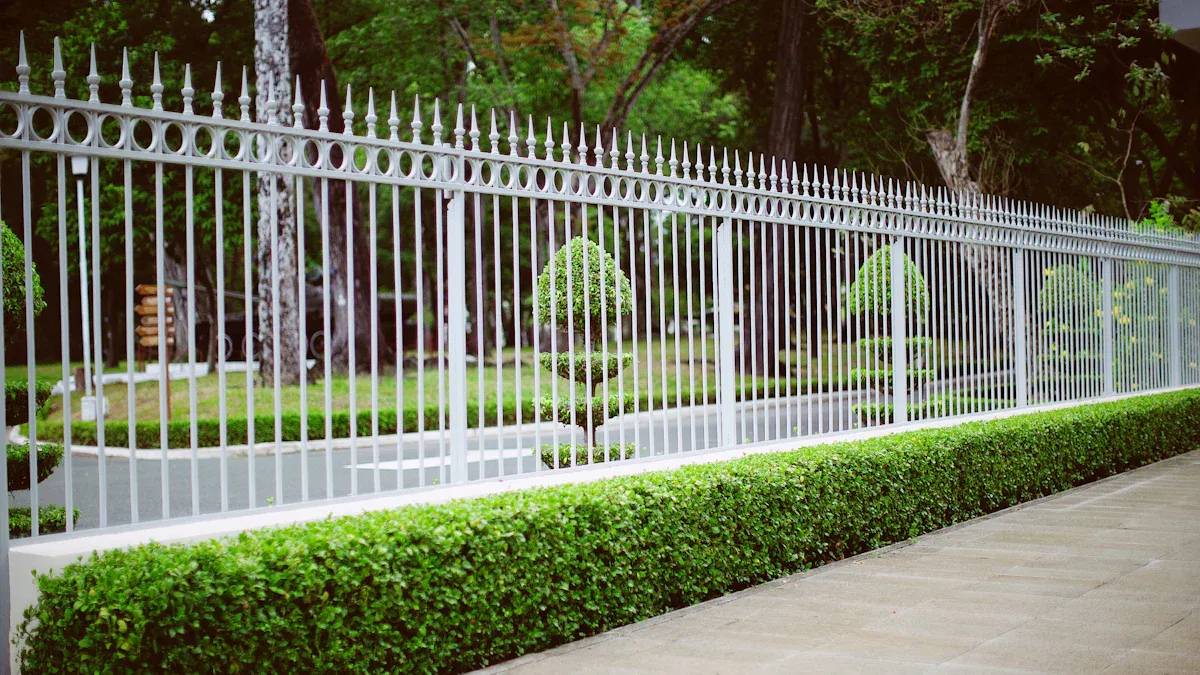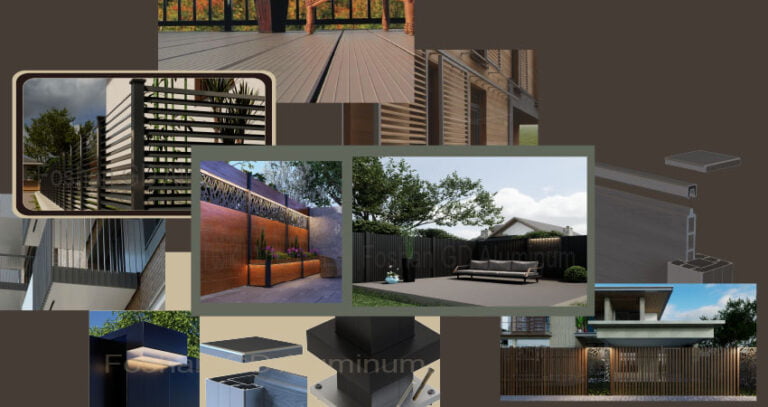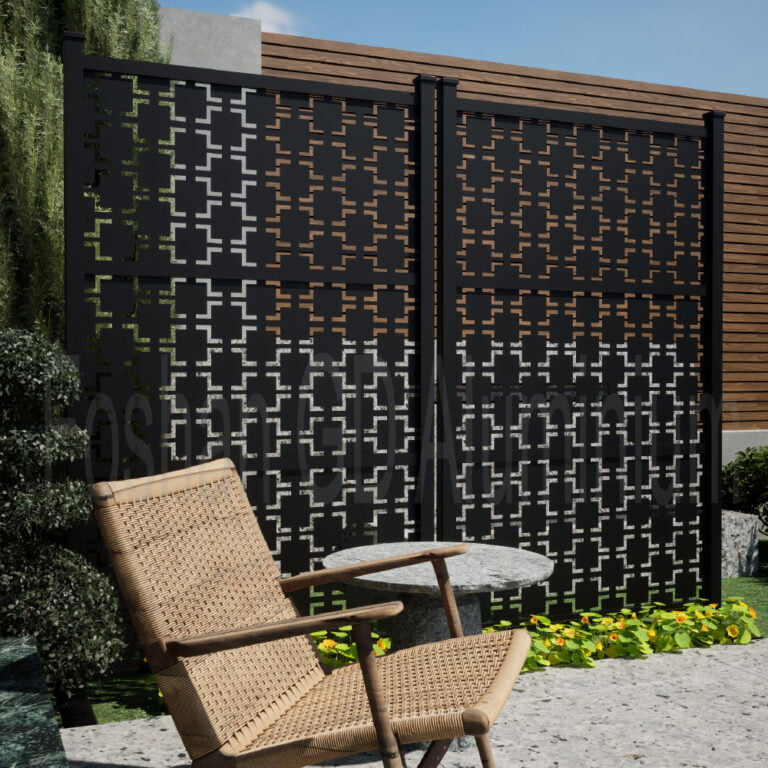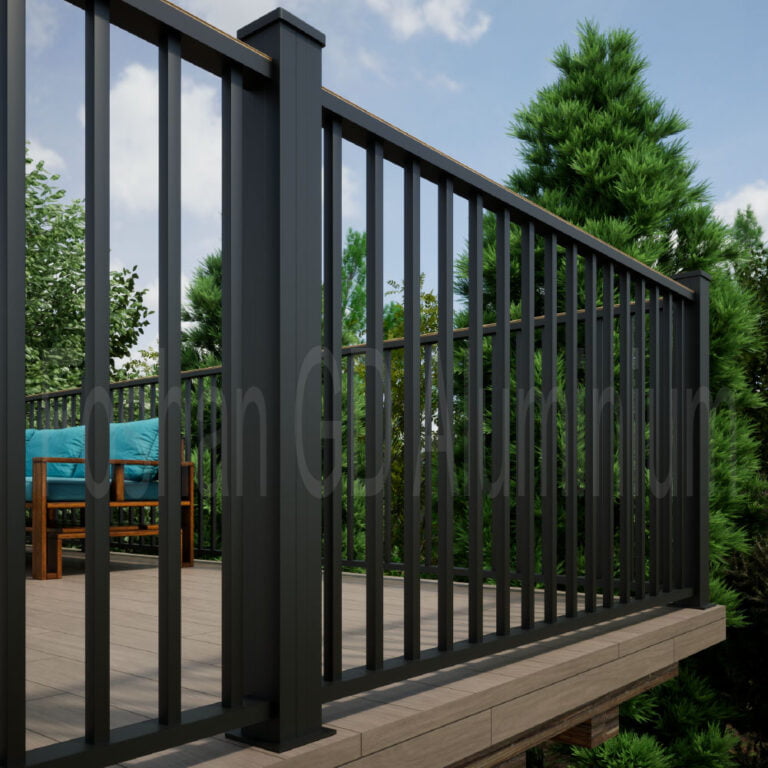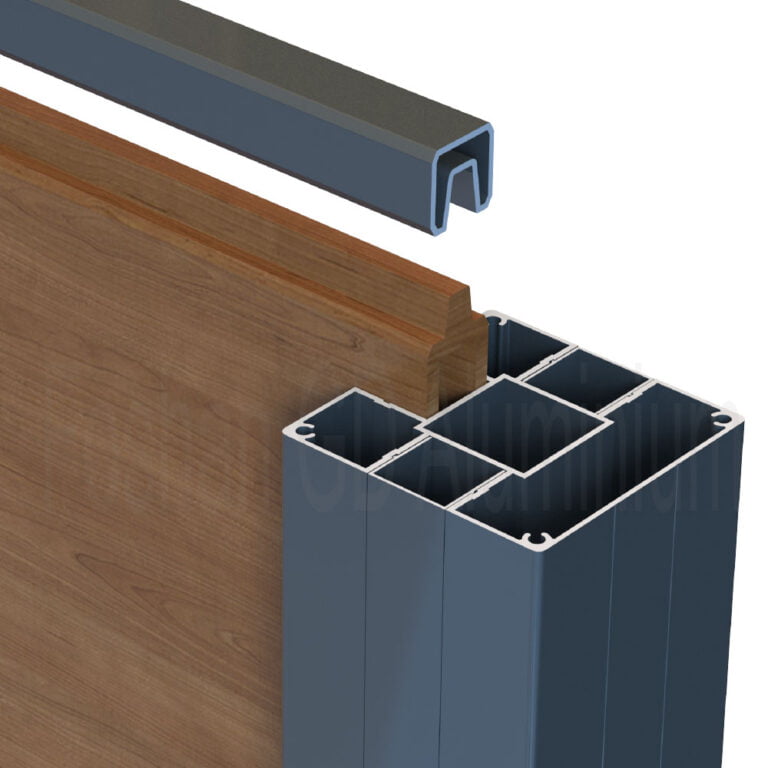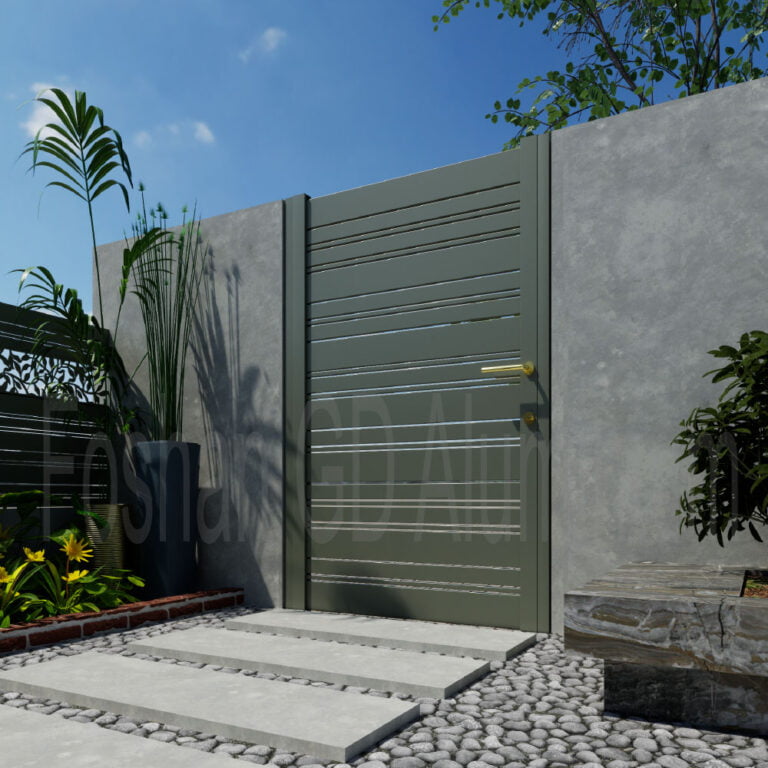Aluminum Privacy Fences Compared to Wood and Vinyl Fencing
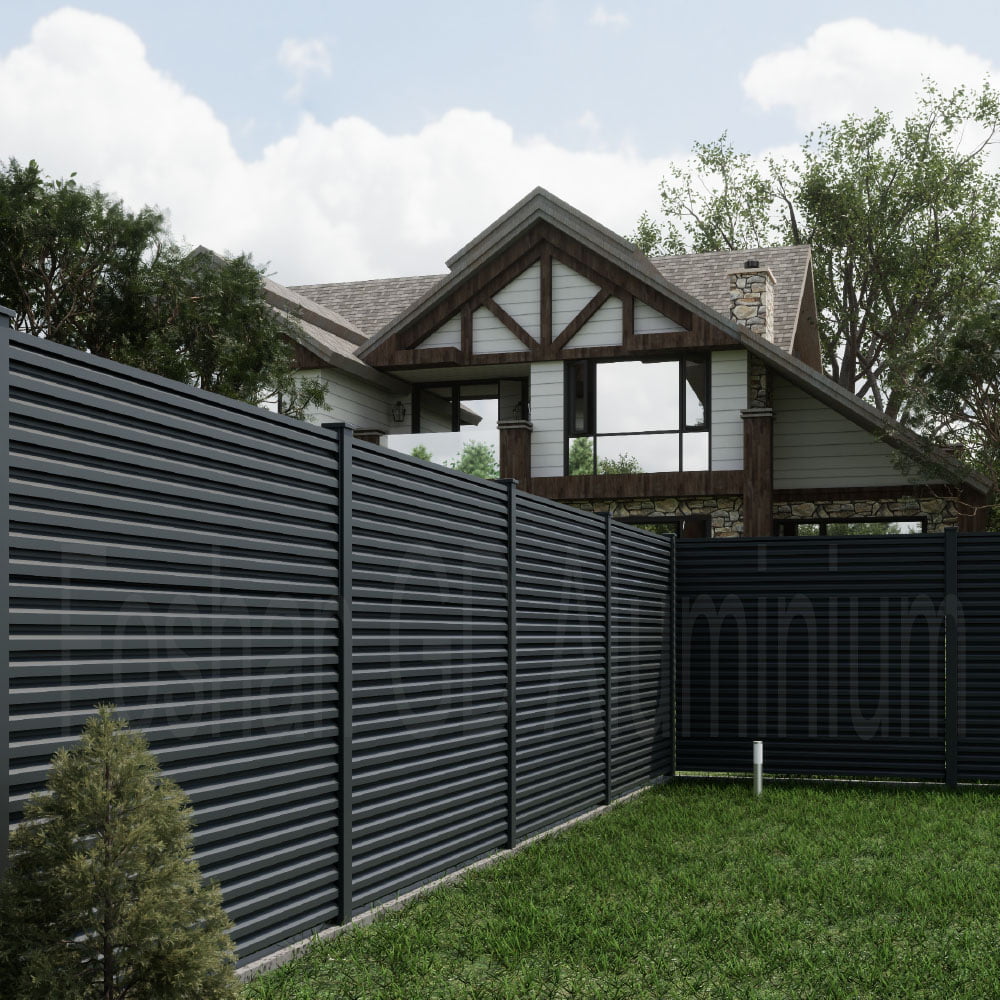
Choosing the right fence affects how your property looks and works. Aluminum, wood, and vinyl fences each have unique benefits. Picking the best one is important for homeowners. Today, more people want fences that are strong, private, and nice-looking, which is why an aluminum privacy fence is becoming a popular choice. Aluminum fences are strong and have a modern style, making them last long. Wood fences are classic and never go out of style. Vinyl fences are easy to take care of and stay popular. Since 59% of homeowners care about durability, knowing these materials helps you choose what fits your needs.
Key Takeaways
Aluminum fences are strong, look nice, and last 30-50 years. They are a good choice for the long term.
Wood fences have a classic style but need regular care. Without care, they can rot or break and last only 10-15 years.
Vinyl fences need little care and don’t rot, but they might crack in very cold weather. They also add to plastic waste.
Think about the cost now and later. Aluminum costs more at first but saves money on repairs over time.
Pick a fence that fits your needs for privacy, strength, and the environment. It will improve your property.
Overview of Fencing Materials
When picking a fence, knowing the materials helps you decide. Aluminum, wood, and vinyl fences each have special features. Below is a simple breakdown of their qualities.
Aluminum Privacy Fence Features
Aluminum fences are strong and easy to care for. They don’t rust or corrode, so they work well in bad weather. These fences are light, making them simple to install but still sturdy. Aluminum posts hold up the fence and stay strong in wind. Aluminum rails don’t bend or break, keeping the fence in good shape. You can also change aluminum pickets to match your style and safety needs.
Feature | Description |
|---|---|
Aluminum Posts | Hold the fence up and stay strong in bad weather. |
Aluminum Rails | Stay straight and don’t break, keeping the fence sturdy. |
Aluminum Pickets | Come in different styles and spacing for safety and looks. |
These fences make your property look modern and add value. They are also recyclable, which is better for the environment.
Wood Fencing Features
Wood fences have a classic look that fits many yards. They give privacy and security while looking natural. You can pick from different wood types and designs to match your style. Installing them right is important so they last longer. Posts need to be set properly to avoid rotting. If cared for, wood fences can last many years.
Comes in many styles and wood types.
Costs less than aluminum or vinyl fences.
Blends well with outdoor spaces.
Tests show treated wood lasts longer and resists decay. But, wood can weather and swell, especially in the first year outside.
Vinyl Fencing Features
Vinyl fences are easy to care for and last a long time. They don’t get damaged by bugs, rot, or bad weather. Vinyl comes in many colors and styles, giving a neat and modern look. Unlike wood, vinyl doesn’t need painting or staining, saving you time.
Needs little care, no painting or staining required.
Resists bugs, rot, and harsh weather.
Comes in many colors and designs.
Looks clean and modern.
Vinyl is strong but may not handle hard hits like aluminum. Still, it’s easy to maintain and looks great, making it a favorite for homes.
Durability Comparison
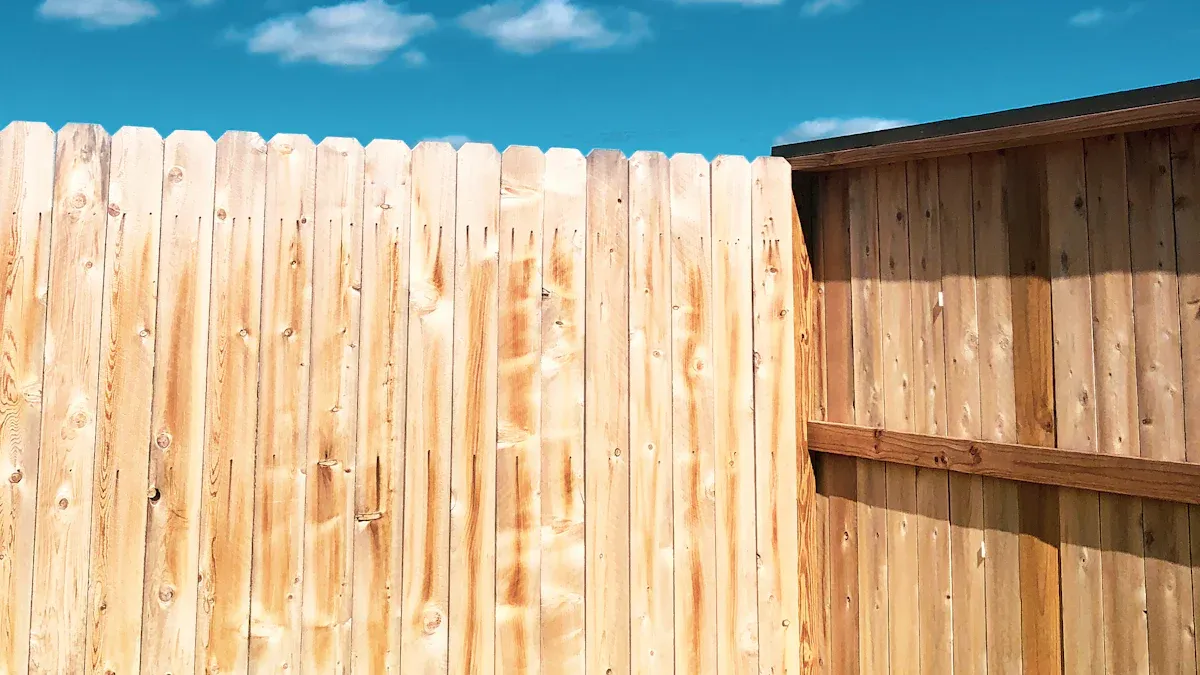
When picking a fence, how long it lasts matters. Aluminum, wood, and vinyl each have their own strengths and weaknesses.
Aluminum Privacy Fence Durability
Aluminum fences are very strong and last a long time. They don’t rust or corrode, even in wet weather. Unlike wood, aluminum won’t bend, crack, or break over time. It is light but strong, so it can handle strong winds and storms. Aluminum also keeps its look for years because it doesn’t fade in the sun or get damaged by heat or cold. This makes it a great choice for people who want a fence that lasts.
Wood Fencing Durability
Wood fences look nice but don’t last as long as aluminum. Wet weather can make wood rot, especially if it’s not treated. Bugs like termites can damage wood fences too. Over time, wood can bend, crack, or break because of weather changes. The sun can also make wood fade and weaken. To make wood fences last longer, you need to seal and stain them often. This takes time and effort to keep them in good shape.
Wet weather can cause wood to rot.
Bugs like termites can damage untreated wood.
Wood can bend, crack, or break over time.
The sun makes wood fade and weaken faster.
Vinyl Fencing Durability
Vinyl fences are strong and easy to take care of. They don’t rot or get damaged by bugs. Rain and wet weather don’t affect vinyl because it doesn’t soak up water. But in very cold weather, vinyl can crack if hit hard. Even so, vinyl fences keep their color and shape for many years. They don’t need painting or staining, which makes them a favorite for people who want a strong and low-maintenance fence.
Maintenance Requirements
Aluminum Privacy Fence Maintenance
Taking care of an aluminum privacy fence is simple and affordable. These fences don’t rust or corrode, so repairs are rare. Still, checking the fence twice a year helps keep it in great shape. Look for cracks, loose posts, or algae during inspections. Once a year, clean the fence with soap and water to remove dirt. Trim plants near the fence and fix scratches with paint to keep it looking nice. Lubricate gate hinges to ensure they work smoothly.
How Often | |
|---|---|
Check for cracks or damage | Twice a year |
Inspect for loose posts or panels | Twice a year |
Look for algae or mold | Twice a year |
Wash with soap and water | Once a year |
Trim plants near the fence | Once a year |
Oil gate hinges and latches | Once a year |
Hiring experts to plan maintenance based on your area’s weather can help. This way, you can fix small problems early and keep your aluminum privacy fence strong and good-looking for a long time.
Wood Fencing Maintenance
Wood fences need more care to stay strong and beautiful. Check them often for bending, cracks, or termite damage. Seasonal care, like adding protective coatings, stops moisture from causing rot in winter. Clean the fence with mild soap and water to remove dirt. Re-stain or seal the wood every two to three years to make it last longer.
Common Problems: Skipping protective coatings or ignoring damage can cost more later.
Helpful Tips: Use good-quality sealants and check the fence after storms.
Protective Coatings: Weatherproof finishes protect wood from sunlight and water damage.
Guides like Conserve 2023 offer advice on choosing the right finishes and seasonal care. Following these tips helps your wood fence stay a beautiful part of your yard.
Vinyl Fencing Maintenance
Vinyl fences are very easy to care for. They don’t need painting, staining, or sealing. Washing them with soap and water a few times a year keeps them clean. Unlike wood, vinyl doesn’t rot or attract bugs. But in very cold weather, vinyl can crack, so check for damage after winter.
Cleaning with soap and water is enough.
No painting or sealing needed, saving time and money.
Costs less to maintain than wood, which can cost $500–$700 yearly.
Because vinyl is durable, it doesn’t need many repairs. This makes it a great choice for homeowners who want a low-maintenance and long-lasting fence.
Cost Analysis
Initial Costs of Aluminum Privacy Fences
Aluminum privacy fences cost more at first than some other fences. However, they last long and need little care, saving money over time. The price for aluminum fencing is usually $35 to $56 per foot. This is higher than chain link fences, which cost $12.60 to $42 per foot. But aluminum saves money later because it doesn’t rust or corrode. It’s a great choice for people who want a strong and stylish fence.
Cost Range: $35–$56 per foot
Key Benefits: Saves money over time, low upkeep, modern look
Initial Costs of Wood Fences
Wood fences have different prices based on the wood type and style. Cedar and pressure-treated pine are common, costing $35 to $90 per foot for cedar and $45 to $90 for pine. Cheaper woods like spruce and cypress cost $22 to $43 per foot. Expensive woods like redwood and tropical hardwood can cost up to $120 per foot. Fence styles also affect cost. Privacy fences cost $25 to $50 per foot, while picket fences cost $20 to $40.
Wood Type | Average Price per Foot (Installed) |
|---|---|
Pressure-treated pine | $45–$90 |
Cedar | $35–$40 |
Cypress | $27–$43 |
Spruce | $22–$35 |
White oak | $30–$75 |
Black locust | $40–$80 |
Western red cedar | $45–$90 |
Composite | $55–$85 |
Redwood | $35–$120 |
Tropical hardwood | $35–$55 |
Fence Style | Average Cost per Foot (Installed) |
|---|---|
Privacy | $25–$50 |
Picket | $20–$40 |
Split rail | $15–$35 |
Initial Costs of Vinyl Fences
Vinyl fences come in many styles, so their prices vary. Today’s Homeowner says vinyl costs 30% to 50% more than treated wood. For example, vinyl decking can cost twice as much as southern pine, a cheaper wood. But the price difference is smaller when compared to costly woods like redwood or cedar. Vinyl fences look neat and modern. They also need little care, making them worth the higher starting cost.
Today’s Homeowner says vinyl decking costs 30–50% more than pressure-treated wood. Also, Workbench magazine says vinyl decking can cost twice as much as southern pine, the cheapest wood. But the price gap is smaller when compared to pricier woods like tropical hardwood, redwood, or cedar. Vinyl fencing costs vary because it can be made into many styles for looks or function.
Long-Term Costs and Value
When picking a fence, think about both the starting price and the long-term costs. Aluminum, wood, and vinyl fences each have their own pros and cons over time.
Aluminum Privacy Fences: A Smart Long-Term Choice
Aluminum fences cost more at first but save money later. They don’t rust, corrode, or get damaged by weather, so repairs are rare. You won’t need to paint, stain, or seal them regularly. Aluminum fences stay strong and look good for many years. This makes them a great choice for people who want a durable and low-maintenance fence.
Tip: Aluminum fences from GD Aluminum can be recycled, which is better for the planet.
Wood Fences: More Work, More Costs
Wood fences are cheaper to buy but cost more over time. You need to stain, seal, and fix them often to keep them in good shape. Weather can make wood bend, crack, or fade, so replacements are common. While wood looks natural and pretty, it takes a lot of effort and money to maintain, making it less affordable in the long run.
Vinyl Fences: Easy Care, Decent Value
Vinyl fences are affordable and last a long time. They don’t rot, attract bugs, or get damaged by bad weather. But in very cold weather, vinyl can crack, which might mean repairs. Vinyl keeps its color and finish for years but doesn’t last as long as aluminum. For people who want a low-maintenance fence with fair value, vinyl is a good pick.
Key Takeaway: Aluminum fences give the best value because they last long, need little care, and are eco-friendly.
Aesthetic Appeal
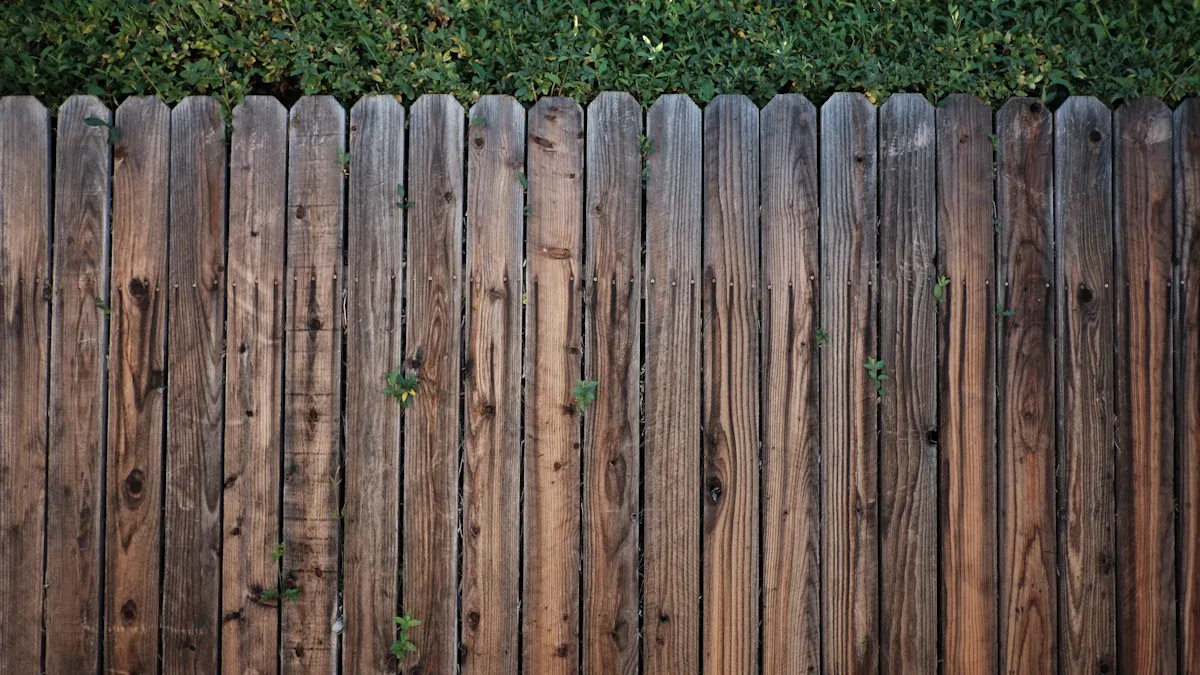
Design Options for Aluminum Privacy Fences
Aluminum privacy fences give homeowners many design choices. You can pick different heights, like 4′, 5′, or 6′, or even custom sizes to fit your needs. These fences come in various styles, such as spear tops for extra security, flat tops for a modern look, or puppy panels with smaller gaps to keep pets safe.
Tip: Make your aluminum fence look better with decorative post tops, finials, or custom designs for pools or spas.
Aluminum fences are elegant, rust-proof, and easy to maintain, so they stay beautiful for years. You can also combine aluminum with materials like wood or stone for a unique and stylish design.
Design Options for Wood Fences
Wood fences have a natural and classic look that fits most yards. You can choose from different wood types, like cedar, pine, or whitewood, each with its own texture and finish. Vertical board fences are popular because they offer privacy and block noise.
Wood is very flexible for design. You can paint or stain it to match your house or leave it natural for a rustic feel. Add lattice tops or carvings for a personal touch.
Popular Styles: Picket fences, split rail fences, and shadowbox designs.
Customization Options: Paint, stain, or natural finishes.
Wood fences are a symbol of privacy and tradition, making them a favorite in the U.S.
Design Options for Vinyl Fences
Vinyl fences have a clean, modern look and come in colors like white, tan, and gray. They offer styles like privacy panels, semi-private designs, and picket fences to match your home’s style.
Unlike wood, vinyl doesn’t need painting or staining, making it easy to care for. Some vinyl fences even have textured finishes that look like wood, giving you both beauty and durability.
Note: Vinyl fences are perfect for homeowners who want a neat look without much upkeep.
Vinyl fences keep their color and finish for years, staying attractive in your yard.
Privacy and Security
Privacy Features of Aluminum Privacy Fences
An aluminum privacy fence is a modern way to keep your space private. It uses tightly spaced pickets or solid panels to block views into your yard. This makes it great for backyards, patios, or pool areas where you want peace and quiet. Aluminum fences come in different heights, usually between 4 and 6 feet, so you can pick the privacy level you need.
These fences are not just useful but also look nice. You can add decorative touches like finials or post caps to make them more stylish while keeping your privacy. Aluminum is strong and lasts a long time, even in bad weather. This makes it a smart choice for people who want privacy and a durable fence.
Tip: Add hedges or trees near your aluminum fence for extra privacy and beauty.
Privacy Features of Wood Fences
Wood fences are a timeless option for privacy. Their solid panels or overlapping boards create a natural wall that blocks views well. You can pick styles like stockade or board-on-board to get the privacy you want. Taller wood fences, up to 8 feet, are great for bigger yards or homes close to neighbors.
Wood is flexible in design. You can paint or stain it to match your home or garden. But, you need to take care of it by sealing and staining regularly. This keeps the fence strong and stops gaps from forming due to shrinking or warping.
Privacy Features of Vinyl Fences
Vinyl fences are great for privacy with their solid, interlocking panels. These panels leave no gaps, giving full coverage and a neat look. Vinyl fences come in heights from 4 to 8 feet, making them good for homes and businesses.
Vinyl is easy to care for. It doesn’t warp, crack, or need painting, so it stays private and looks good for years. Vinyl fences also come in many colors and textures, including ones that look like wood, so you can have both privacy and style.
Note: Vinyl fences are safe for kids and pets because they are smooth and sturdy.
Environmental Impact
Sustainability of Aluminum Privacy Fences
Aluminum fences are a green and eco-friendly option. They last for many years and need little care. This means fewer replacements, which reduces waste and saves resources. Aluminum fences also don’t need many cleaning products, lowering their impact on the environment.
When aluminum fences are no longer used, they can be recycled. This helps cut down on trash and supports reusing materials. The table below shows why aluminum fences are a sustainable choice:
Key Factor | Description |
|---|---|
Durability | Aluminum fences last for decades with little maintenance. |
Maintenance | They need less care, making them better for the environment. |
Recyclability | Aluminum can be fully recycled, reducing waste and pollution. |
Choosing aluminum fences helps protect the planet and promotes sustainability.
Sustainability of Wood Fences
Wood fences are natural and renewable, but their eco-friendliness depends on how the wood is sourced. To make sure your fence is sustainable, check if the supplier has certifications. Labels like FSC™ (Forest Stewardship Council) and PEFC (Program for the Endorsement of Forest Certification) show that the wood comes from responsibly managed forests. These certifications help protect nature and promote good forestry practices.
Certification | Description |
|---|---|
FSC™ | Ensures wood is sourced responsibly and forests are managed sustainably. |
PEFC | Supports sustainable forestry through independent checks and certifications. |
Pick wood fences from suppliers who follow eco-friendly practices. This helps protect forests and supports the environment.
Sustainability of Vinyl Fences
Vinyl fences are strong and easy to care for, but they impact the environment more than aluminum or wood. Making vinyl uses non-renewable materials like oil and releases harmful gases. Vinyl also doesn’t break down naturally, so it can add to landfill waste.
Some companies now use recycled materials to make vinyl fences. If you choose vinyl, look for these eco-friendlier options. While vinyl is convenient, it’s not as environmentally friendly as aluminum or responsibly sourced wood.
Advantages and Disadvantages of Aluminum Privacy Fences
Advantages of Aluminum Privacy Fences
An aluminum privacy fence has many benefits for homeowners. It lasts a long time, usually 30 to 50 years, which is much longer than wood fences that last about 20 years. Aluminum does not rust or corrode, making it great for wet or coastal areas. Unlike wood, it won’t bend, crack, or attract bugs. This makes it strong and easy to care for. You only need to clean it sometimes and check for damage, saving time and money.
Aluminum fences are also light, so they are easy to install. You can customize them by choosing different heights, styles, and designs. This lets you match the fence to your home’s look while keeping your yard private and safe. Aluminum is also good for the environment because it can be recycled, which helps reduce waste.
Expert Insight: Aluminum fences need less care than wood or vinyl. They don’t need painting, staining, or pest treatments, making them a smart and cost-saving choice over time.
Metric | Aluminum Fencing | Vinyl Fencing |
|---|---|---|
Durability | Strong, resists rust, low maintenance | Resists rot, bugs, and decay |
Privacy | Less private than wood or vinyl | Offers better privacy |
Installation Ease | Lightweight, simple to install | Heavier, harder to install |
Cost | Costs more upfront ($2,430 – $6,500) | Cheaper upfront ($2,300 – $5,800) |
Disadvantages of Aluminum Privacy Fences
Even though aluminum fences have many good points, they also have some downsides. One issue is the higher starting cost. Aluminum fences usually cost between $2,430 and $6,500, which is more than wood or vinyl fences. But because they last longer and need less care, they can save money over time.
Another downside is that aluminum fences don’t block views as well as wood or vinyl. Many designs have spaces between the pickets, so people might still see into your yard. You can choose solid panels or add plants for more privacy, but these options can cost more. Also, while aluminum is strong, it may not handle heavy hits as well as some other materials.
Even with these drawbacks, the long life, low upkeep, and eco-friendly features of aluminum fences make them a great choice for many homeowners.
Picking the best fence material depends on what you need. Aluminum, wood, and vinyl fences each have their own strengths. Comparing how long they last, care needs, and eco-friendliness shows their differences. Aluminum fences are recyclable, easy to care for, and last 20–30 years. Wood looks natural but needs a lot of care and lasts only 10–15 years. Vinyl is strong but adds to plastic waste and cannot be recycled.
Feature | Metal Fences | Wood Fences | Vinyl Fences |
|---|---|---|---|
Recyclability | Can be recycled easily | Limited, often becomes waste | Not recyclable |
Life Expectancy | 20–30 years | 10–15 years | 20–30 years |
Maintenance Needs | Easy to maintain | Needs frequent care | Low to moderate care |
Environmental Impact | Little waste over time | High waste from rot | Plastic waste problems |
An aluminum privacy fence is strong, stylish, and eco-friendly. It handles bad weather well and needs little upkeep. If you want a fence that lasts and helps the planet, aluminum is the best choice.
FAQ
1. How long does an aluminum privacy fence last?
Aluminum fences can last 30 to 50 years. They resist rust and bad weather, staying strong in tough climates. With little care, they remain reliable for decades.
Tip: Check and clean your aluminum fence often to keep it lasting longer.
2. Are aluminum fences more expensive than wood or vinyl?
Aluminum fences cost more upfront, about $35–$56 per foot. But they need less care and last longer, saving money over time compared to wood or vinyl.
Material | Starting Cost (Per Foot) | Care Cost |
|---|---|---|
Aluminum | $35–$56 | Low |
Wood | $22–$120 | High |
Vinyl | $30–$50 | Low |
3. Can aluminum fences provide complete privacy?
Yes, aluminum fences can block views with solid panels or close pickets. These designs keep your yard private while looking modern and stylish.
Note: Add plants or decorations to make your fence even more private and pretty.
4. Are aluminum fences eco-friendly?
Aluminum fences are very eco-friendly. They can be fully recycled, cutting down waste. Their long life means fewer replacements, which helps the planet.
5. What maintenance does an aluminum privacy fence require?
Aluminum fences are easy to care for. Wash them once a year with soap and water. Check for loose parts or scratches twice a year. Oil gate hinges yearly to keep them working well.
Care Tips:
Clean with soap and water: Once a year
Look for damage: Twice a year
Oil hinges: Yearly

